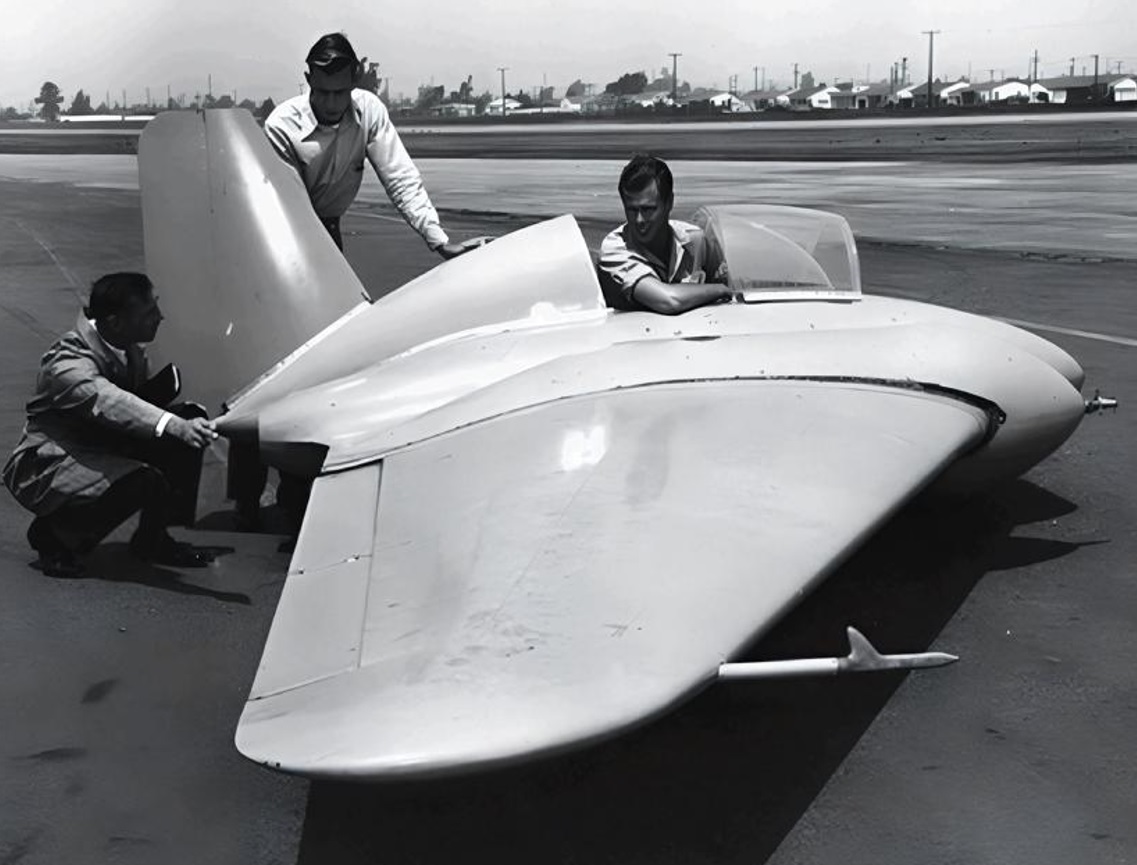Did you know that there are only three of Jack Northrop’s “Flying Wings” known to be left in the world? The Western Museum of Flight is extremely fortunate to have one of them, the Northrop JB-1 “Bat”. The other two are the Northrop N-1M at the Smithsonian National Air and Space Museum, Washington, D.C., and the beautifully restored Northrop N-9MB at the “Planes of Fame Museum,” Chino, California. (Video below of the JB-1 (MX-543) man-carrying glider)
During June 1996, the Western Museum of Flight’s JB-1 restoration team consisting of Rick Hilton, Alex Von Tol, and Fred Erb lovingly restored the Northrop JB-1 “Bat.”
As a direct result of Great Britain’s experiences with the German V-1 “buzz bombs,” the USAAF considered the development of similar weapons. In late 1943, Northrop was awarded an USAAF contract to design and develop a Flying Wing “Power Bomb.” Under secret Project MX-543, two Northrop Model JB-1 air vehicles were built.
The first airframe built was the Western Museum of Flight’s JB-1 man-carrying glider. Its unusual shape earned it the name “Bat.” Except for the pilot’s cockpit and canopy, the JB-1 glider was the unpowered aerodynamic equivalent of the second version, the jet powered JB-1A (Note: all of the 3-view drawings are of the JB-1A.) The JB-1 was used to explore the design’s flight characteristics.
The JB-1 piloted version was lifted aloft as a glider by means of a tow aircraft. Tow hitches are visible at the tips of the two bomb containers. Only one man-carrying JB-1 was built to test the flying qualities of this flying-wing design. The center section of the JB-1 glider version included two stream-lined “torpedo-shaped” bomb containers. The center section was fabricated of formed and welded magnesium alloy plate. The wing panels were made of riveted and spot-welded aluminum alloy sheet with magnesium wingtips. The pilot’s cockpit was located in the space that would be used for the jet engine installations in the unmanned JB-1A powered model.
In 1944, Northrop test pilot Harry Crosby made the initial glider flights out of Muroc Dry Lake, using airplane tows to get airborne. Following the successful glider flights, the second model JB-1A was equipped with a pair of General Electric Type B1 turbojet engines replacing the pilot.
The JB-1A Power Bomb was designed as a ground-launched, pilotless airplane with a pre-programmed guidance system. This onboard system was to guide the Power Bomb with reasonable accuracy to a target approximately 200 miles away, at which point it was to make a terminal dive into the target zone with its bomb load. The design ordnance consisted of two 2,000-pound demolition bombs, one in each wing root container.
JB-1and JB-1A "Bat" Specifications
| ****** | JB-1 | JB-1A |
| Manufacturer | Northrop Aircraft, Inc., Hawthorne, California | Northrop Aircraft, Inc., Hawthorne, California |
| Number Built | One | One |
| Crew | Pilot | None |
| Wing Span | 28 feet, 4 inches | 28 feet, 4 inches |
| Overall Length | 10 feet, 6 inches | 10 feet, 6 inches |
| Overall Height | 4 feet, 6 inches | 4 feet, 6 inches |
| Launch Weight | n/a | 7,080 pounds |
| Launch Speed | n/a | 160 mph |
| Speed (Cruising) | n/a | 427 mph at 5,000 feet |
| Range | n/a | 670 miles |
| Powerplants | None | (2) General Electric Type B1 400-lb thrust jet engines |
| Armament | None | (2) 2,000 lb. bombs |




